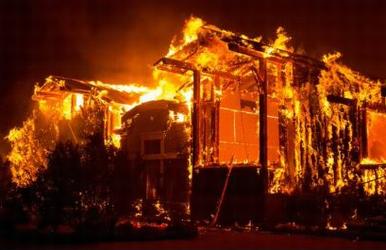
SACRAMENTO, California, October 27, 2019 (ENS) – California Governor Gavin Newsom today declared a statewide emergency due to the effects of unprecedented high-wind events that have resulted in wildfires and evacuations across the state.
Citing extreme peril posed by wildfire risk, Governor Newsom issued an Emergency Proclamation directing CAL FIRE to immediately implement projects to
protect lives and property.
At least 180,000 Northern California residents, many enduring the third precautionary power shutdown in a month, have been ordered to evacuate their homes as historic winds drove an outburst of wildfires in the San Francisco Bay Area.

The Kincade Fire in Sonoma County has burned more than 30,000 acres to date, and has led to the evacuation of almost 200,000 people and threatened hundreds of structures.
As of today, over 3,000 local, state and federal personnel, including first responders, are assisting with the Kincade Fire alone.
The Kincade Fire grew to 84 square miles on Sunday and was only five percent contained as of 7:10 pm local time, forcing authorities to impose mandatory evacuations for 180,000 residents of Sonoma County, famous for its wines.
The historic Soda Rock winery in Healdsburg burned to the ground. Soda Rock is the original site of the Alexander Valley general store and post office and was once a central hub of activity. Historic records provide evidence of the first bonded winery on the property in 1880.
Healdsburg and Windsor, north of Santa Rosa along Highway 101, were evacuated Saturday, and on Sunday morning fire officials ordered holdouts to leave immediately, warning that high the winds were pushing the fire fast. The National Weather Service recorded one gust Sunday morning at 93 mph just outside Healdsburg. Officials said 79 structures had been destroyed and 31,000 others were threatened.
Through the day, hundreds of firefighters held the fire at Windsor, a city of 27,000, stopping it from getting to the other side of Highway 101.
Flames also flared on both sides of Interstate 80 near the Carquinez Bridge in Vallejo, 20 miles north of Oakland, forcing the freeway to be temporarily shut down in both directions and the nearby California State University Maritime Academy to be evacuated.
The Tick Fire in Southern California also destroyed structures, threatened homes and critical infrastructure, and caused the evacuation of tens of thousands of residents. By the day’s end, crews in the Santa Clarita area north of Los Angeles had made progress battling the Tick Fire.
“We are deploying every resource available, and are coordinating with numerous agencies as we continue to respond to these fires. It is critical that people in evacuation zones heed the warnings from officials and first responders, and have the local and state resources they need as we fight these fires,” said Governor Newsom.

The governor also announced a $75 Million program for state and local governments to mitigate impacts of power shutoffs and unveil a series of new partnerships and new tools to help secure medically vulnerable populations during these events.
On Saturday, the state’s largest utility, Pacific Gas and Electric Company, PG&E, began “de-energization” of its electrical lines as part of a Public Safety Power Shutoff, PSPS, the third this month.
The PSPS event will impact some 940,000 customers in 38 counties in the Northern and Southern Sierra Foothills, the North Bay and Mendocino, the Bay Area, the Central Coast, and the Central Valley.
“This PSPS action is based on forecasts of historic dry, hot and windy weather that poses a significant risk for damage and sparks on the electric system and rapid wildfire spread,” the utility said in a statement.
But the power shutoffs have been causing other damage. The city of Vallejo declared a water emergency Sunday because its pumping station is unable to treat water due to the pre-emptive power shut-off.
PG&E is undertaking precautionary power shut-offs because the company learned from its experience in last year’s Camp Fire in Northern California, the deadliest and most destructive in the state’s history. PG&E says it’s “probable” that its equipment caused the Camp Fire.
Ignited by a faulty PG&E electric transmission line, on November 8, 2018, the Camp Fire caused at least 85 civilian fatalities, injured dozens of others, and destroyed the densely populated town of Paradise.
It was financially disastrous for PG&E. Facing potential liabilities of $30 billion from the wildfire, on January 14, PG&E began the process of filing for bankruptcy with a 15-day notice of intention to file for bankruptcy protection.
PG&E settled for $1 billion with state and local governments in June and settled for $11 billion with insurance carriers and hedge funds in September. Wildfire victims are the only major group of claimants that have not yet reached a settlement with PG&E.
As utility-initiated Public Safety Power Shutoffs continue to impact residents across California, Governor Gavin Newsom today announced a new Public Safety Power Shutoff Planning Team within the California Health and Human Services Agency and tools to help ensure that medically vulnerable Californians have their needs met during power shutoffs.
Earlier in the week, the Governor secured Fire Management Assistance Grants to help ensure the availability of resources to fight the Kincade and Tick fires and enable local, state and tribal agencies to recover eligible costs.
The governor has also met with first responders, health officials, and residents of Napa, Geyserville, and Los Angeles this week, and held public briefings regarding the ongoing fire threats and the need to hold utilities accountable for the consequences of their decisions to shut off power for large portions of the state.
Copyright Environment News Service (ENS) 2019. All rights reserved.
